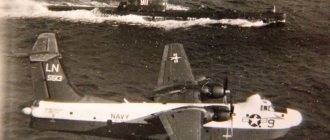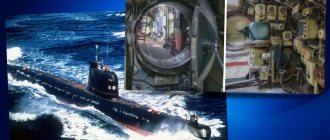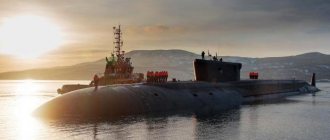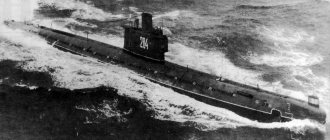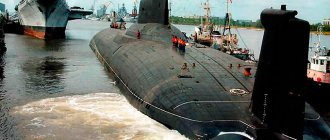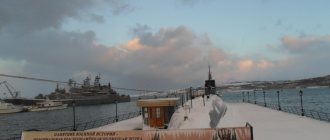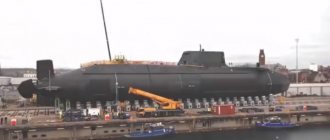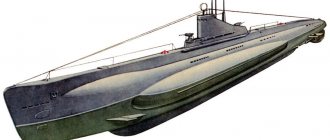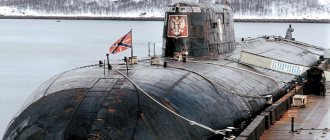“Hello everyone, there is no need to despair” - the suicide note of Lieutenant Commander Kolesnikov.
On August 12, 2000, at 11:28 a.m., a strong flash was recorded on the cruiser “Peter the Great” in the water area where the Russian Northern Fleet was conducting exercises, and then a hydraulic shock. At that moment they did not attach much importance to this. Five hours later, a communication session with the K-141 Kursk submarine followed as planned. But at the appointed time there was silence on the air. The admirals in charge of the exercises became worried, but no one yet thought that one of the largest tragedies of our time was unfolding.
History of creation
The nuclear submarine Kursk is a submarine that has long been considered the best in the Russian Navy. The 949A Antey submarine project was developed in the USSR in the late 1960s.
The Soviet Union was significantly inferior to its main enemy, the United States, in the number of aircraft carriers, so the main goal of the Antey nuclear-powered ships was the ability to quietly approach a well-guarded enemy ship within striking distance and destroy the target.
The Kursk submarine was laid down in Severodvinsk in 1992.
Already in 1994, she was launched and attached to the Northern Fleet. The submarine was considered a special pride also because it was built at a very difficult time for the country. She was considered a symbol of the new Russia.
Armament
The Kursk nuclear submarine was armed with Granit missiles and torpedoes to counter enemy nuclear submarines. Being an inconspicuous ship with a low noise level, she could cause a lot of inconvenience to the enemy just by being in the waters where enemy ships were based. The submarine's armament was the most modern and allowed it to carry out high-precision strikes against both surface and underwater targets.
The size of the submarine was impressive. Its length was a gigantic 154 meters, and its displacement in immersion mode was estimated at almost 24 thousand tons.
Mine
In general, the version of the Kursk colliding with a mine was never on the agenda. Writers and journalists did not see anything “mysterious” in it: this version certainly did not resemble a conspiracy. The technical side of the issue also raises doubts, because the Kursk was one of the largest nuclear submarines in the world, and its destruction by an old mine from World War II is hardly possible.
However, there is a much more plausible hypothesis. As you know, there are different types of mines, and not all of them were created during the Second World War. There is, for example, the American sea mine Mark-60 Captor, which is an anchor container with a Mk.46 torpedo. Special equipment recognizes the noise of enemy submarines, and a torpedo with a cumulative warhead is aimed at the front, most vulnerable part of the boat. A number of experts believe that this is precisely what can explain the presence of a round hole in the front of the Kursk.
American naval mine Mark-60 Captor / ©Wikimedia Commons
Submarine service K-141 "Kursk"
The Kursk submarine was the pride and flagship of not only the Northern Fleet, but also the entire Russian Navy.
The submarine was repeatedly involved in military exercises, including large-scale ones.
Thus, in 1999, in the Mediterranean Sea, a submarine in autonomous navigation mode successfully carried out a training destruction of NATO ships. Thus, the Kursk eliminated the main enemy forces single-handedly, proving its high efficiency in practice.
Disaster and rescue efforts
The exercises, which took place in the Barents Sea in August 2000, were considered the largest since the collapse of the Soviet Union. Of course, the most important role in the scenario was played by the best submarine in Russia - the Kursk nuclear submarine.
During the tests, the submarine had to hide from possible detection, and at the scheduled time, carry out a practice torpedoing of a mock enemy ship. But the plans were not destined to come true.
At 11-28 local time, an explosion was heard, with a power, according to various sources, from 1.5 to 4 on the Richter scale. It is known that it was recorded by many seismic stations and sensors. It was reported that it was caught as far away as Alaska. After 135 seconds, a second explosion occurred, much more powerful than the first.
Already at 13-50 the first “bells” about the misfortune are heard. The submarine crew does not communicate at the scheduled time. The commander of the Northern Fleet immediately flies to the base in Severomorsk. There are no official announcements yet, but it is becoming clear that something irreparable has happened.
On the same day, at 23-30, the “alarm” mode is declared - from that moment the military begins the search for the missing ship.
In the middle of the night, August 13, the approximate search area becomes clear, but only by 16-20 it is possible to detect the Kursk nuclear submarine. Technical contact is established with her, but it is obvious that the submarine is lying on the ground, that is, it has suffered an accident.
We can say that from this moment the actions of the management begin, which cause at least a shock. The rescue operation was not announced for a long time - only on August 14 at 7 am the first rescuers began timid attempts to descend to the depths. High officials look as if they themselves do not understand what is happening and do not know how to act in the current situation.
This causes a flurry of negative emotions from all Russians, but primarily from the relatives of sailors in distress. Footage of the country's president vacationing in Sochi is flying around the world. Afterwards, many become witnesses to no less heartbreaking videos when Vladimir Putin meets with relatives of submariners. Without exaggeration, the whole world is watching the fate of the nuclear-powered ship.
Almost immediately, Norway, which has a well-trained search fleet, offers its assistance. Its bathyscaphes are capable of conducting search and rescue operations at great depths. But the Russian leadership refuses any kind of help for a long time, and when it agrees, it becomes clear that invaluable time has been lost irrevocably.
Only on August 21, the first rescuers were able to open the hatch and enter the sunken boat. At that moment it became clear that there was no one to save. The Kursk was completely flooded.
Following the investigation, the Northern Fleet command announced that the cause of the death of the Kursk submarine was an exploding training torpedo. After this, the submarine hit the ground with its bow, which led to the detonation of the remaining warhead. The crew was almost completely killed, and those who miraculously managed to survive were given no more than 6 hours.
The list of dead was 118 people.
Thus ended the story of the submarine, on which the Russian military leadership had placed special hopes. And the reasons for her death are still shrouded in a series of secrets and coincidences.
Identification of the dead
Over the course of a year, some investigators collected identification signs, interviewing relatives, friends, and colleagues of the deceased submariners, requesting information from medical institutions, even children's clinics. 9 volumes were collected. Also, forensic doctors were provided with medical books found in the 4th compartment.
As of December 19, 73 bodies of dead submariners had been recovered and 65 identified.
In February 2002, it was reported that the crew commander, Captain 1st Rank Gennady Lyachin, and the senior officer on the campaign, Chief of Staff of the 7th Division of the Northern Fleet, Captain 1st Rank Vladimir Bagryantsev, had been identified.
By March 20, 2002, the bodies of 115 dead submariners were discovered and identified.
The bodies of two sailors, Dmitry Kotkov (Koshkov) and Ivan Nefedkov (Nefednov), as well as the chief specialist of Dagdizel, Mamed Gadzhiev, could not be found.
According to the conclusion of a forensic medical examination, the submariners who were in the 9th compartment died from acute carbon monoxide poisoning within 7-8 hours after the disaster.
Alternative versions of the death of the submarine
It so happened that the Kursk disaster became one of the biggest mysteries in Russian history. And there were more than enough reasons for this.
Firstly, the actions of the Russian leadership sometimes defy logical justification.
Secondly, a lot of doubts are generated by the rescue operation, which seemed to be artificially delayed as much as possible.
Thirdly, the Russian military was extremely reluctant to the idea of raising the submarine, although it is logical to assume that this would simplify the investigation and shed light on the cause of the tragedy. As a result, it was decided to raise the nuclear submarine in parts, with the bow section cut off, and this is at least alarming.
The country's leadership's excuses that this was a necessity due to the incomprehensible state of the nuclear engine still left doubts.
Fourthly, today we know a huge amount of materials similar to the truth, proving the presence of American submarines in the Barents Sea, which could, by pure chance, cause the death of the flagship of the Russian fleet.
It will probably never be possible to find out the whole truth about the Kursk tragedy. Even future generations will most likely not be able to understand what it was: the possible start of the Third World War or banal carelessness.
And all this mystery, of course, gives rise to a large number of conspiracy theories and theories with a lot of evidence and refutations. The most popular alternative versions of the Kursk tragedy are as follows:
- Accidental collision with an American spy submarine;
- Criminal negligence in the installation of live torpedoes;
- Deliberate sabotage of exercises. It is known that there were representatives of China in the fleet who were interested in concluding large contracts for the supply of Russian weapons. Probably due to the actions of some third party, the submarine was liquidated for an unknown reason. Of course, at the highest level the truth was revealed quickly, but what followed was a political game, and the people were “fed” the most plausible version of what happened.
Perhaps no version was as popular as the probable collision with overly “curious” NATO submarines.
It is known for sure that large-scale exercises in the North of Russia attracted special attention from the United States.
It later turned out that the Memphis submarine had the task of getting as close as possible to the exercise arena and observing the unfolding events. From this moment the most controversial hypotheses begin, which are often supported by many facts.
One of the main engines of this version is the investigative film by French director Jean Michel Carré, “Submarine in Troubled Waters.” So, it is known (photo and video evidence was even provided for this) that the Memphis was put in for urgent repairs at the nearest Norwegian base immediately after the disaster with the Russian submarine.
Many eyewitnesses and rescuers claim to have heard distress signals from the Kursk, which means that the crew could have survived for a long time. This does not fit with the official conclusion that almost all the sailors died instantly from explosions and flooding.
On the other hand, the distress signals could have come from the damaged Memphis, which either collided with a Russian submarine or was hit by a retaliatory torpedo launch.
The proven fact that two explosions were recorded also indicates a possible “shootout”.
In addition, a rescue buoy released from a submarine was found in the waters near the crash site. In turn, most sources claim that the buoy on the Kursk remained in its place.
The official version of the explosion of a training torpedo on board the nuclear submarine also caused a great resonance. In some sources you can find facts that simply speak of unacceptable sloppiness in the Russian fleet.
The newest torpedo, fueled with hydrogen fuel, was placed incorrectly, which led to the leakage of the flammable substance, its further ignition, and then the detonation of the main warhead. According to this theory, the submarine was not adapted to install weapons of this class, and in preparation for the exercises a number of glaring mistakes were made, which, overlapping each other, ultimately led to a tragic outcome.
Some time after the tragedy, a version according to which Vladimir Putin deliberately hid from the public the true causes of the disaster in the Barents Sea gained high popularity. This theory is supported by the fact that all the big bosses who had access to information or carried out rescue work were sent on vacation shortly after the end of the investigation.
The decision, of course, taken by the president, according to which the submarine was raised in a sawn state, also made the public doubt the transparency of the investigation.
The entire crew was awarded the Order of Courage posthumously, and the captain was awarded the honor of becoming a hero of Russia. And even here the impression was created that the government was trying to get out, because formally high ranks were given for exercises in the Mediterranean in 1999.
There is a large amount of evidence that the Russian leadership was in close contact with American intelligence agencies immediately after the incident. In addition, it became known that a few days later the United States forgave Russia a large debt, and the CIA director secretly visited Russia a few hours after the incident, when the boat had not even been looked for. In turn, this makes us believe that the Russian President deliberately took into account the version of the mistake of his own military and made it public in order to avoid a possible military conflict with the United States.
Popular discontent was also provoked by Vladimir Putin’s subsequent interview with the famous American journalist and TV presenter Larry Obrian. To the presenter’s question, “What happened to the Kursk submarine?”, the Russian President answered with a grin: “It drowned.”
A wide public outcry broke out again when the bodies of the submariners were recovered. Among other things, it became known about a letter from Captain Dmitry Kolesnikov. The people's minds were excited by part of the note, which was immediately classified as “Secret”. The management referred to the fact that the cut out part of the letter was of a purely personal nature, but the captain’s wife had still not received the original note from her husband.
Who knows, perhaps the surviving sailors, in complete darkness, by touch, wrote words that ordinary people were not supposed to know.
Submarine collision
One version says that the Kursk could have collided with an American submarine. Captain 1st Rank Mikhail Volzhensky also adheres to this version. The main culprit is said to be the Toledo submarine, which belongs to the Los Angeles class of nuclear submarines. US Navy submarines actually monitored the Russian navy's exercises. All of them have high stealth, which allows them to get as close as possible to domestic ships.
This version has a number of contradictions. Any Western multi-purpose submarine is incomparably smaller than the Kursk: the length of the Los Angeles-class boat is 109 m versus 154 for the Kursk. The most powerful American multi-purpose submarine of the Seawolf type has a length of 107 m. Let us add that Project 949A boats are incomparably wider and, in general, more massive than those overseas. In other words, the collision with the Kursk was supposed to cause even greater harm to the Americans themselves. But none of the US Navy boats were damaged then.
The hypothesis about a collision with a surface ship has similar roughnesses. To sink the Kursk, the blow had to be of colossal force, and still the probability of the death of such a large boat would be insignificant.
In the fifth compartment of the Kursk there was a recorder, as well as watch documentation damaged during the tragedy. At the time of the disaster, the Snegir tape recording equipment was turned off, although the regulations require that it be turned on during firing practice. Thus, it was not possible to restore the speakerphone conversations at the time of death. A total of 22 tape recordings were deciphered. Three notes from the submariners themselves were also found on board, but none of them answered the question about the causes of the tragedy. At least that's what was officially stated.
Memory
The tragic death of the newest Russian submarine did not leave anyone indifferent, it would seem. Since then, many poems and books have been written that are dedicated to the memory of the dead sailors. The film “72 Meters,” based on the tragedy, received wide success in cinemas.
People's memory is immortalized in many monuments that are installed throughout the country.
The most famous of them are located in Moscow, Kursk, Severodvinsk and Murmansk.
All this is evidence that the tragedy with the Kursk nuclear submarine is a big wound in the memory of the people of Russia, which is why there is so much that is not understood and accepted in this story, and what is left unsaid still resonates with pain and powerlessness in the minds of millions of people.

